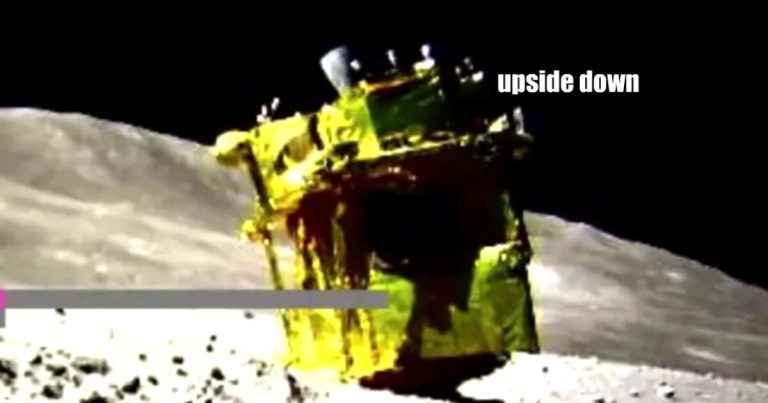
The bitter tale of Japan's historic lunar lander has seen another dramatic development, with photographic evidence showing the SLIM module upside down on the moon's surface.
Read: Japan launches a lunar mission using the “SLIM” lunar lander and the “XRISM” X-ray telescope in an attempt to join the club of space superpowers
The Lunar Investigation Intelligent Lander (SLIM) appears to have landed on its nose, according to an image taken by the SORA-Q robotic lander, which was successfully ejected before the lander touched down last week.
Future reported:
The Japan Aerospace Exploration Agency admitted in a statement that “a defect in the main engine affected the landing position of the spacecraft.” statement.
The image also explains why SLIM had major problems generating power with its obscured solar panels, something that eventually forced scientists to shut it down just three hours after landing.
Read: The Japanese SLIM spacecraft lands on the moon, but a problem with the solar panels will significantly shorten the mission
The lander appears to have no way to right itself.
The successful and accurate landing of SLIM on the moon made Japan the fifth country in the world to land a spacecraft on the moon, after the Soviet Union, the United States, China and India. But problems quickly became apparent: the solar cells were not charging, the lander had to be stopped three hours after landing, and there was only 15% of battery power remaining.
Japanese agency JAXA was putting a hopeful smile on things.
“If sunlight strikes the Moon from the west in the future, we believe there is potential for power generation, and we are currently preparing for recovery,” the Japan Aerospace Exploration Agency wrote.
Lunar Expedition 2 (LEV-2/SORA-Q) successfully captured an image of the planet #Moderate build Spacecraft on the moon. LEV-2 is the world's first robot to conduct fully autonomous exploration on the lunar surface. https://t.co/NOboD0ZJIr pic.twitter.com/mfuuceu2WA
— JAXA Institute for Space and Astronautics (@ISAS_JAXA_EN) January 25, 2024
Even with SLIM “asleep”, the image taken by SORA-Q followed the path of Mission Control's Plan B, having first been transmitted to a second robot called LEV-1 that was also successfully deployed during landing. For its part, LEV-1 is equipped with a way to autonomously communicate with Earth.
The Japan Aerospace Exploration Agency still describes the mission as a major win.
“The accomplishment of LEV-1’s lunar jump movements, inter-robot communication between LEV-1 and SORA-Q, and fully autonomous operations represent a groundbreaking accomplishment,” the agency said. “It will be seen as a valuable technology demonstration for future lunar explorations, and the knowledge and experience gained will be applied in upcoming missions.”
Read more:
Waiting for the Sun: Solar Cells Facing the Wrong Direction, Thin Japanese Lander 'Stops Sleeping' on the Moon – Sun Rays from the West on May Rescue Mission

